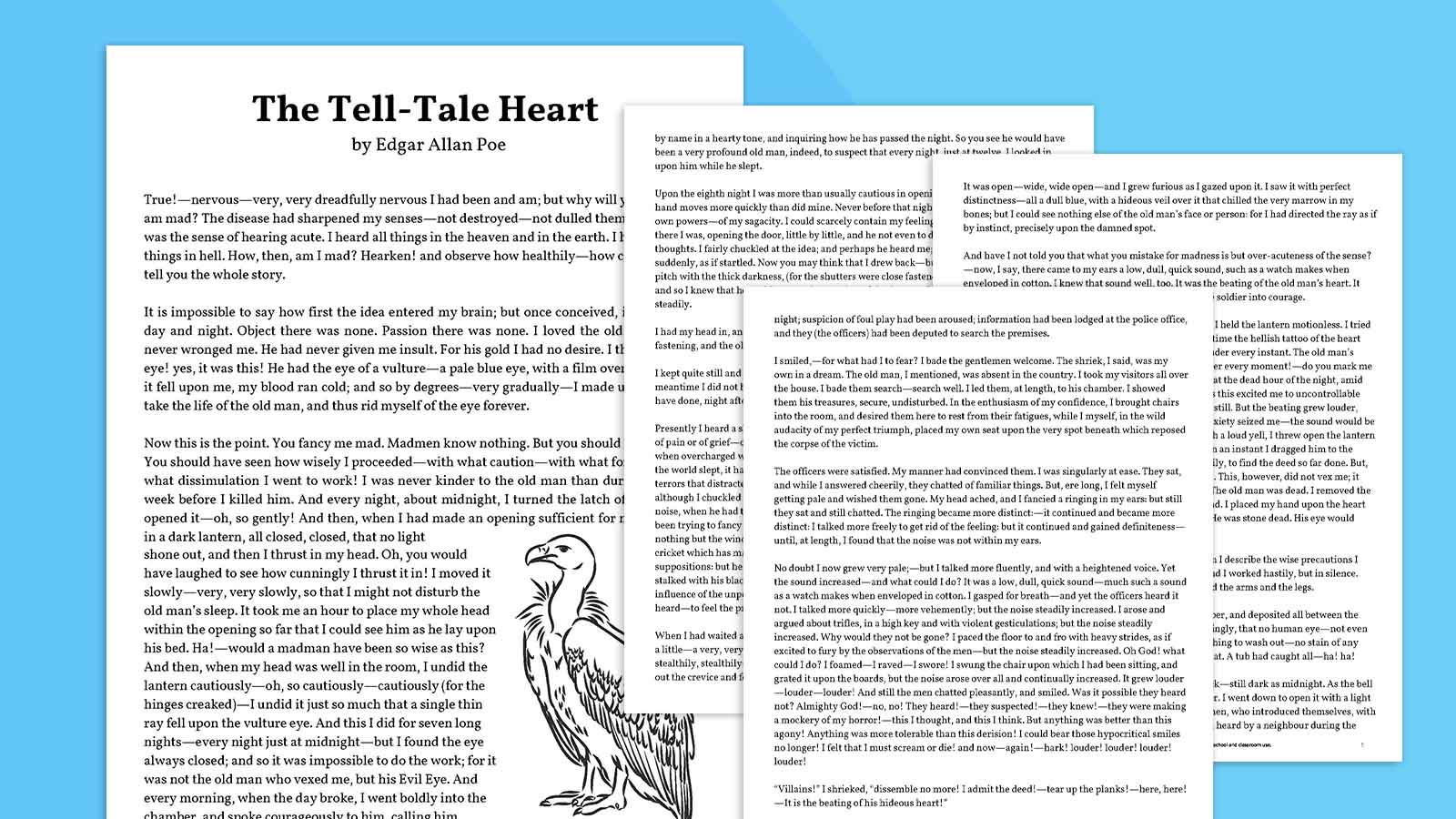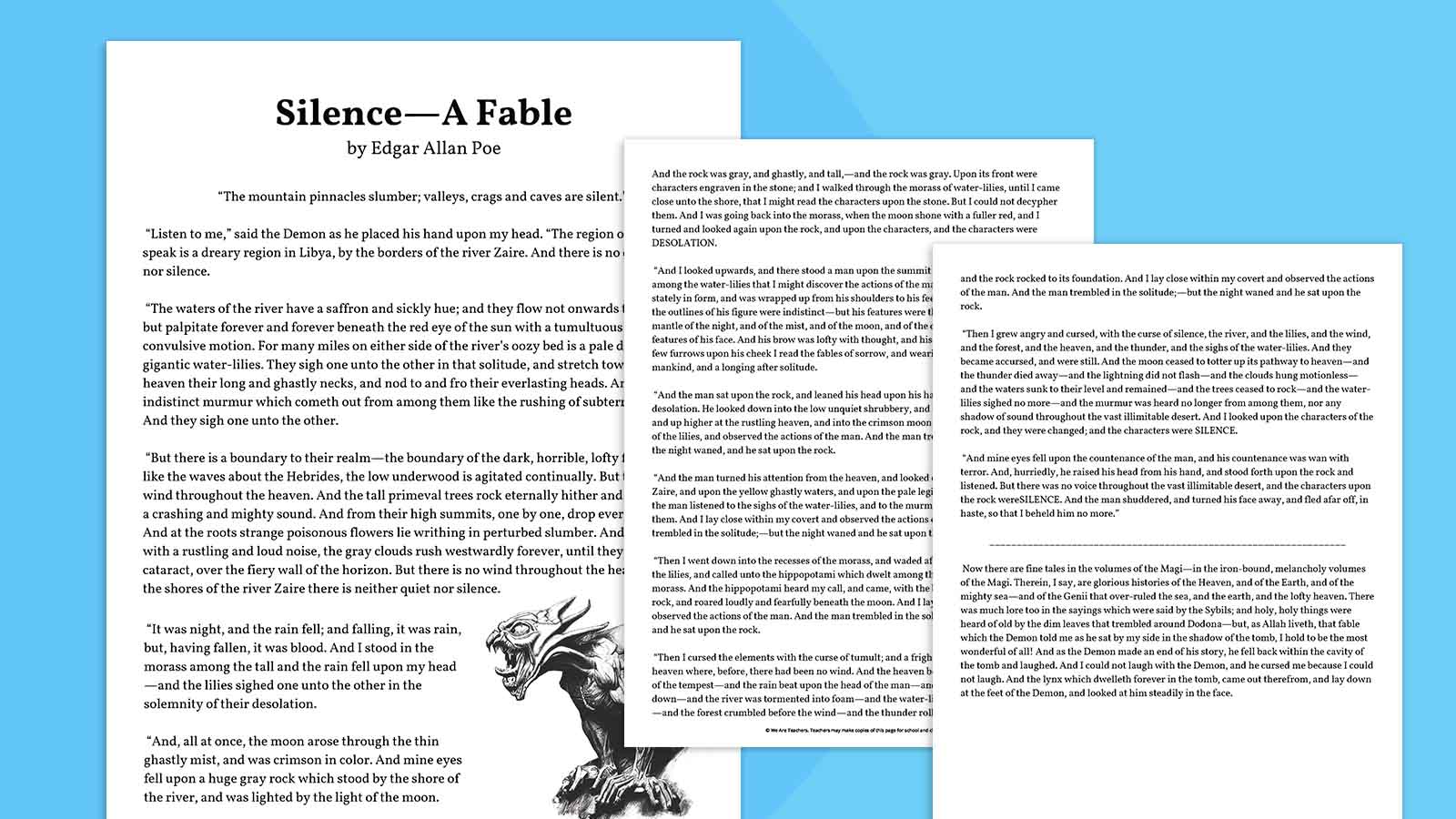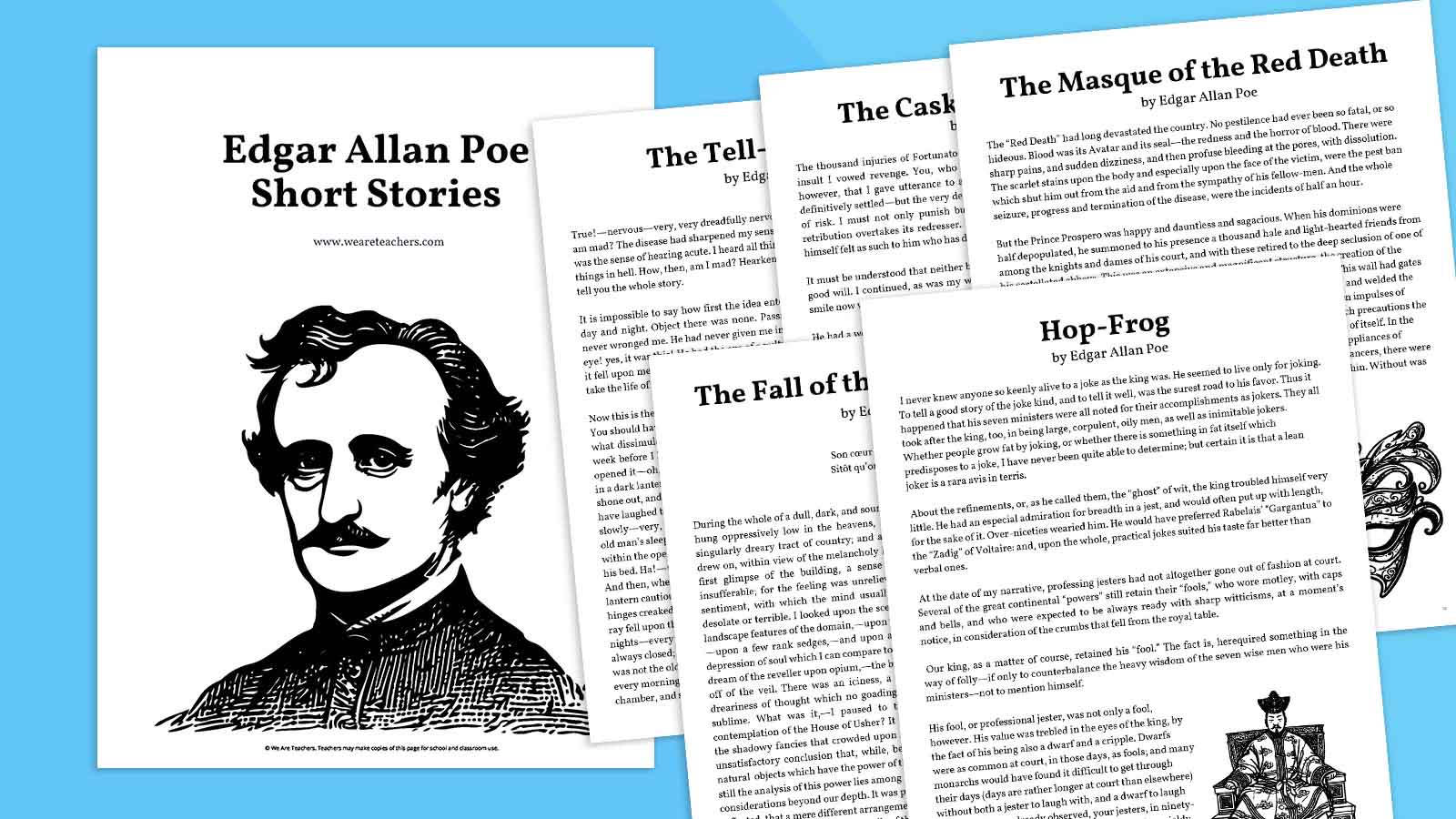Edgar Allan Poe (1809–1849) is best known for his horror and mystery writing, but he wrote much more than that. Poe’s writing career started in 1827 when he released the book of poems Tamerlane and Other Poems, and since then he’s become famous for his poetry and short stories. His first popular publication was The Raven in 1845. That’s when Poe became a well-known, albeit not wealthy, writer. Students can’t (and shouldn’t) graduate from middle or high school without reading at least a few Edgar Allan Poe’s short stories.
Poe’s writing spans genres including horror, gothic, and detective stories. As a writer, Poe didn’t like being too didactic or using lots of allegory. He thought the meaning should run just under the surface of writing. And Poe was a writer of his time, using references to popular pseudosciences like phrenology in his stories. Edgar Allan Poe’s short stories, like his poems, often deal with themes of death, mourning, and other grim topics.
These 16 Edgar Allan Poe short stories are enough to fill a unit all about Poe, or to satisfy students who read his well-known work “The Tell-Tale Heart” and just can’t get enough. Of course, Poe’s writing is mature, so make sure the story is appropriate for your particular student audience.
Get the free story printables to use with your students by filling out the form on this page.
The Tell-Tale Heart

“I heard all things in the heaven and in the earth. I heard many things in hell. How, then, am I mad? Hearken! and observe how healthily—how calmly I can tell you the whole story.”
“The Tell-Tale Heart” is perhaps the most well-known Edgar Allan Poe short story. Written in 1843, it is a crime-horror story in which Poe walks the boundary between obsession and madness as the narrator explains what drives him to murder. This story is a master class in mood, pacing, and building suspense. And there are so many references to it in later stories that it’s a great Poe work to start with.
Learn more: 25 Edgar Allan Poe Poems
The Cask of Amontillado
“It must be understood, that neither by word nor deed had I given Fortunato cause to doubt my good will. I continued, as was my wont, to smile in his face, and he did not perceive that my smile now was at the thought of his immolation.”
This 1846 story is a great read-aloud as Poe creates an engaging soliloquy with a revengeful narrator describing how he is calculating a murder. And—classic Poe—it’s both grim and funny with dark humor.
The Masque of the Red Death
“The ‘Red Death’ had long devastated the country. No pestilence had ever been so fatal, or so hideous. Blood was its Avatar and its seal—the redness and the horror of blood.”
In “The Masque of the Red Death,” Prince Prospero seals himself off from the world and the “Red Death” with 1,000 friends. This ball quickly turns into a nightmare. For students, this is an example of a wonderfully baroque story and, with the COVID pandemic such a recent experience for students, perhaps a very relatable story as well.
The Purloined Letter
“We gave him a hearty welcome; for there was nearly half as much of the entertaining as of the contemptible about the man, and we had not seen him for several years.”
Poe is well known for his detective stories—even Arthur Conan Doyle gave a nod to Poe for creating the detective story—and this is a great example. Read this story with students as an introduction to mystery and detective stories so you start with a story that has all the elements.
The Fall of the House of Usher
“During the whole of a dull, dark, and soundless day in the autumn of the year, when the clouds hung oppressively low in the heavens, I had been passing alone, on horseback, through a singularly dreary tract of country; and at length found myself, as the shades of the evening drew on, within view of the melancholy House of Usher.”
“The Fall of the House of Usher” was appreciated even in the 19th century for its haunting imagery. This story incorporates several themes into one—a premature burial, a young woman stalked by death, madness, and a cataclysmic storm—all there for students to analyze and interpret.
The Pit and the Pendulum

“The sentence—the dread sentence of death—was the last of distinct accentuation which reached my ears. After that, the sound of the inquisitorial voices seemed merged in one dreamy indeterminate hum.”
This story is a wonderful example of building suspense. The main character is a prisoner during the Spanish Inquisition and is sentenced to torture and death. The way Poe writes, with lines that swing back and forth like the pendulum above the narrator, effectively builds from one event to the next.
William Wilson
“Let me call myself, for the present, William Wilson. The fair page now lying before me need not be sullied with my real appellation.”
Poe pulls from his own childhood experience at Scottish and English schools for this doppelgänger story, but it’s not necessarily autobiographical. We can understand the two William Wilson characters as a man and his conscience.
Ligeia
“‘Here then, at least,’ I shrieked aloud, ‘can I never—can I never be mistaken—these are the full, and the black, and the wild eyes—of my lost love—of the Lady—of the LADY LIGEIA.’”
Poe published this story in 1838, at the start of a golden period when he published most of his mystery and horror stories. In this story, Lady Ligeia shows that human will can be stronger than death by coming back to life in the body of the narrator’s second wife. As you study Poe, bring this story into the classroom to talk about how Poe uses narrative elements to tell one-of-a-kind stories.
Hop-Frog
“It is supposed that Trippetta, stationed on the roof of the saloon, had been the accomplice of her friend in his fiery revenge, and that, together, they effected their escape to their own country; for neither was seen again.”
This is another Edgar Allan Poe story about revenge. It was published in 1849, just months before Poe’s death. In this story, the main character is a dwarf in the king’s court who plans retribution after the king lashes out at a kind woman in the court. And because it’s Poe, the revenge is nothing if not hellish.
The Facts in the Case of M. Valdemar
“Of course I shall not pretend to consider it any matter for wonder, that the extraordinary case of M. Valdemar has excited discussion. It would have been a miracle had it not—especially under the circumstances.”
The act and science of hypnosis was a fascination during Poe’s time, and in this story, the main character uses hypnosis to try to prolong the life of his dying friend. The story progresses into a grisly ending. It’s a true example of a horror story that hits on all cylinders.
The Murders in the Rue Morgue
“The mental features discoursed of as the analytical, are, in themselves, but little susceptible of analysis. We appreciate them only in their effects. We know of them, among other things, that they are always to their possessor, when inordinately possessed, a source of the liveliest enjoyment.”
This story introduces us to the first fiction detective, C. Auguste Dupin. He comes from a wealthy family but has lost his wealth because of unfortunate events (an archetype in Poe’s work). The narrator meets Dupin and the two move into an abandoned mansion, after which they hear about a murder. Plan extra time with this story as it’s longer. It would be a good option to read with students after they are familiar with Poe’s style and writing.
A Descent Into the Maelstrom

“‘Not long ago,’ said he at length, ‘and I could have guided you on this route as well as the youngest of my sons; but, about three years past, there happened to me an event such as never happened to mortal man—or at least such as no man ever survived to tell of—and the six hours of deadly terror which I then endured have broken me up body and soul. You suppose me a very old man—but I am not.’”
Students can analyze Poe’s choices in this story. The narrator is told the story of a man who survived a whirlpool (the maelstrom), but was third person the best choice for this story? And how were the characters developed, or were they not developed enough? The story is a testament to Poe’s writing and mastery of the English language.
The Oval Portrait
“Rapidly and gloriously the hours flew by and the deep midnight came. The position of the candelabrum displeased me, and outreaching my hand with difficulty, rather than disturb my slumbering valet, I placed it so as to throw its rays more fully upon the book.”
This is a short short story that starts with two hikers taking a break when they come to a large house. They break into the house (of course) and start to read books in the house. Then, the story becomes an allegory about the conflict between art and life.
The System of Doctor Tarr and Professor Fether
“During the autumn of 18–, while on a tour through the extreme southern provinces of France, my route led me within a few miles of a certain Maison de Sante or private mad-house, about which I had heard much in Paris from my medical friends.”
In this story, the narrator takes the opportunity to stop at a mental hospital (as one does), where he misunderstands what is happening, creating a humorous story. It also shows Poe’s range as this is an absurdist comedy within one of Poe’s typical settings.
The Premature Burial
“A careful investigation rendered it evident that she had revived within two days after her entombment; that her struggles within the coffin had caused it to fall from a ledge or shelf to the floor, where it was so broken as to permit her escape.”
This story explores the idea of being buried alive, which was a theme for Poe. It does have an ending that could be either disappointing or a relief, depending on the reader.
Silence—A Fable

“Then I grew angry and cursed, with the curse of silence, the river, and the lilies, and the wind, and the forest, and the heaven, and the thunder, and the sighs of the water-lilies. And they became accursed, and were still.”
This is a pretty dense story, but its format (a fable) and topic (a protagonist trying to understand the nature of silence) are both important for understanding Poe’s storytelling range.
Get free printables of these Edgar Allan Poe short stories
Just share your email address for instant access to full-text printable versions of all the Edgar Allan Poe short stories on this list.

